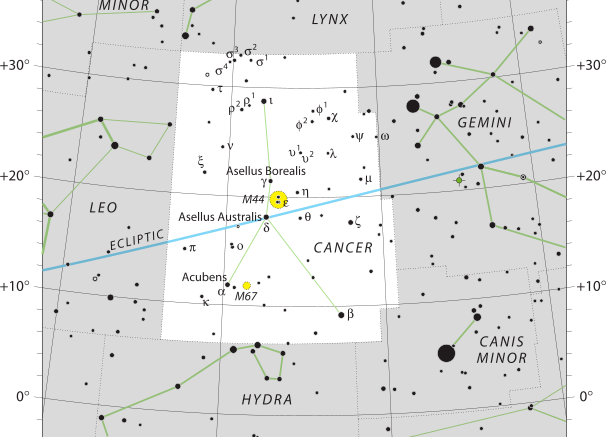1 of thee 12 zodiac constellations, Cancer is located in the Northern celestial hemisphere, with its name being Latin for crab. The constellation is commonly represented as a carb. Cancer is a medium-size constellation with an area of 506 square degrees and its stars are rather faint, with its brightest star Beta Cancri having an apparent magnitude of 3.5.
It contains two stars with known planets, including 55 Cancri, which has five: one super-earth and four gas giants, one of which is in the habitable zone and as such has expected temperatures similar to Earth. At the heart of this sector is Praesepe, otherwise known as Messier 44, one of the closest open clusters to Earth and a popular target for amateur astronomers.
Covering 506 square degrees or 0.921% of the sky, it ranks 31st of the 88 constellations in size. It can be seen at latitudes between +90° and -60° and is best visible at 9 p.m. during the month of March. Covering 506 square degrees or 0.921% of the sky, it ranks 31st of the 88 constellations in size. It can be seen at latitudes between +90° and -60° and is best visible at 9 p.m. during the month of March. Under city skies, Cancer is invisible to the naked eye.
| Applicable Information | |
| Visibility In Pacific Northwest | September to May |
| Best Times To View | February to May |
| Right Ascension | 07h 55m 19.7973s–09h 22m 35.0364s |
| Declination | 33.1415138°–6.4700689° |
| Area | 506 square degrees |
| Main Stars | 5 |
| Brightest Object | β Cnc |
| Meteor showers | Delta Cancrids |
| Messier objects | 2 |
| Neighboring Constellations | Lynx, Gemini, Canis Minor, Hydra, Leo, Leo Minor |
History
Cancer was first recorded by Ptolemy in the 2nd century AD in Almagest, under the Greek name Καρκίνος or Karkinos.
In Greek mythology, Cancer is identified with the crab that appeared while Heracles fought the many-headed Hydra. Hercules slew the crab after it bit him in the foot. Afterwards, the goddess Hera, an enemy of Heracles, placed the crab among the stars.
The modern symbol for Cancer represents the pincers of a crab, but Cancer has been represented as many types of creatures, usually those living in the water, and always those with an exoskeleton.
In the Egyptian records of about 2000 BC the constellation was described as Scarabaeus, the sacred emblem of immortality. In Babylonia the constellation was known as MUL.AL.LUL, a name which can refer to both a crab and a snapping turtle. On boundary stones, the image of a turtle or tortoise appears quite regularly and it is believed that this represents Cancer since a conventional crab has not so far been discovered on any of these monuments. There also appears to be a strong connection between the Babylonian constellation and ideas of death and a passage to the underworld, which may be the origin of these ideas in later Greek myths associated with Hercules and the Hydra.
In the 12th century, an illustrated astronomical manuscript shows it as a water beetle. Albumasar writes of this sign in Flowers of Abu Ma’shar. A 1488 Latin translation depicts cancer as a large crayfish, which also is the constellation’s name in most Germanic languages. Jakob Bartsch and Stanislaus Lubienitzki, in the 17th century, described it as a lobster.
Stars
Of all the zodiacal constellations, Cancer is the 2nd dimmest as it has only two stars above the fourth magnitude. The German cartographer Johann Bayer used the Greek letters Alpha through Omega to label the most prominent stars in the constellation, followed by the letter A, then lowercase b, c and d. Within the constellation’s borders, there are 104 stars brighter than or equal to apparent magnitude 6.5.
Cancer is best known as the home of Praesepe, Messier 44, an open cluster also called the Beehive Cluster, located right in the center of the constellation. Located about 590 light-years from Earth, it is one of the nearest open clusters to our Solar System. M 44 contains about 50 stars, the brightest of which are of the sixth magnitude. Praesepe is also one of the larger open clusters visible, with an area of 1.5 square degrees, or three times the size of the full Moon. It is most easily observed when Cancer is high in the sky. North of the Equator, this period stretches from February to May.
The smaller, denser open cluster Messier 67 can also be found in Cancer, 2600 light-years from Earth. It has an area of approximately 0.5 square degrees, the size of the full Moon. It contains approximately 200 stars, the brightest of which are of the tenth magnitude.
Used to measure the speed of gravity, QSO J0842+1835 is a quasar in the constellations boundaries.
Make sure to check out other articles on the site, including a brief introduction to constellations, other constellation articles, and more!

Be the first to comment on "Cancer"